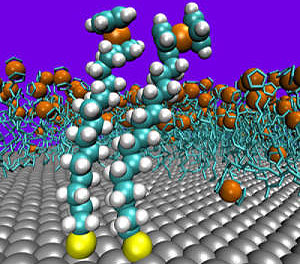Mar 13 2013
A recent breakthrough by scientists from NUS and University College Cork may mean the arrival of highly energy-efficient smart phones and tablets that can last up to 10 times their usual life.
 Redox active ferrocenealkanethiol molecules pack together and assemble into monolayer thin films on silver electrodes. Molecules standing tall instead of crouching form tighter assemblies, which dramatically improve the device properties.
Redox active ferrocenealkanethiol molecules pack together and assemble into monolayer thin films on silver electrodes. Molecules standing tall instead of crouching form tighter assemblies, which dramatically improve the device properties.
A group headed by Assistant Professor Christian A Nijhuis from the NUS Department of Chemistry and Dr Damien Thompson from Tyndall National Institute at University College Cork, Ireland managed to overcome the great challenge of developing miniature active components that do not overheat while showing electrical properties, to create ultra-small devices using molecules. These items are so small that 50,000 of them can be lined up back-to-back to fit on the diameter of a human hair.
The team succeeded in designing the devices with a tenfold jump in switching efficiency by altering just one carbon atom of the active molecular component. By acting as electrical valves, these molecules allow current to flow through them when switched on and stop current flow when switched off. The Singapore scientists packed these molecules tightly on metal electrode surfaces, and the defect-free assemblies can suppress leakage currents to operate efficiently and reliably. The device can be switched on and off cleanly based on the charge and shape of the molecules.
Through experiments and high-performance computer simulations, the investigators demonstrated for the first time that tiny enhancements in molecule orientation and packing trigger changes in van der Waals forces that hold molecules together. The modifications are substantial enough to dramatically raise the performance of electronic devices.
The weakest of intermolecular bonds, van der Waals forces only become significant when summed over large areas, thus the majority of research into ultra-small devices has used the stronger π-π interactions to stick molecules together. The current study shows how van der Waals interactions present in every conceivable molecular scale device can be tuned to optimise the performance of the device. Molecules with an odd number of carbon atoms stand straighter and thus pack more closely than those with an even number of carbon atoms. The findings establish the feasibility of boosting device performance by forming tighter attachment between molecules.
These nano products could mean new ways to counter overheating in mobile phones and laptops, as well as help the electrical stimulation of tissue for wound healing. The innovative work has been published in the February issue of Nature Nanotechnology.
The researchers are following up on new ideas arising from these exciting results, to ultimately invent a range of novel components for molecular electronic devices, said Dr Nijhuis.